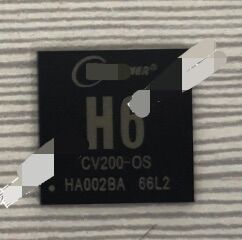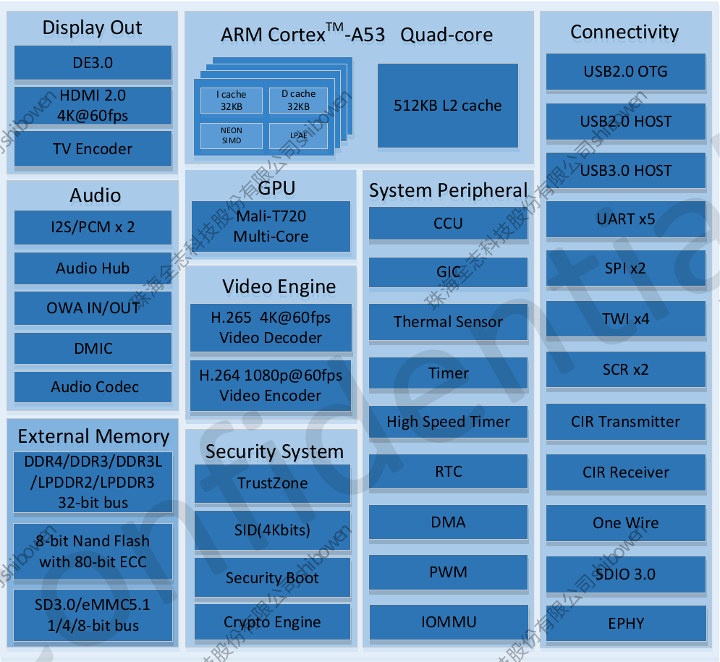Allwinner H6 SoC has been around a few years, first used exclusively in Zidoo H6 Pro TV box, but then finding its way into other TV boxes, and some single board computers such as Orange Pi 3 or Pine H64 model B.
There’s no a cost-down version called Allwinner H6 VC200-OS with most of the same features but without the mostly useless PCIe port (since it does not work well on H6), and other interfaces.
I’ve gone through Allwinner H6 (V200) specifications and highlighted the ones missing or updated in H6 VC200-OS using stricken bold or bold text using information from the datasheet.
- CPU – Quad-core ARM Cortex A53 with NEON, hardware Java acceleration, and FPU
- 3D GPU – Dual shader ARM Mali-T720 with support for OpenGL ES3.1/3.0/2.0/1.1, OpenCL 1.1/RenderScript, Microsoft DirectX 11 FL9_3
- Memory I/F – DDR4/DDR3/DDR3L/LPDDR2/LPDDR3 interfaces
- Storage I/F – 1x eMMC 5.1 flash interface, 1x NAND Flash interface for SLC/MLC/TLC flash memory with up to 80-bit error-correcting code (ECC), 1x SPI NOR Flash interface, 1x SD Card 2.0
- Multimedia
- Video Decoder
- H265/HEVC Main/Main10 profile @ Level5.2 High-tier 4K@60fps,
up to 6Kx4K@30fps - H264/AVC BP/MP/HP @ level 4.2, MVC, 4K@30fps
- VP9 Profile 0/2, 4K@60fps
VP6/VP8, 1080p@60fps- MPEG1/MPEG2 SP@ML, MP@HL, 1080p@60fps
- MPEG4 SP@level 0~3, ASP@level 0~5, GMC, short header format, 1080p@60fps
- AVS+/AVS JIZHUN profile@level 6.0, 1080p@60fps
- VC-1 SP@ML, MP@HL, AP@level 0~3, 1080p@60fps
- H.263 BP, 1080p @ 60 fps
- Xvid: 1080p60
- Supports Frame Buffer Compression(FBC)
- Output pixel format configurable, YUV420/YV12/NV12
- H265/HEVC Main/Main10 profile @ Level5.2 High-tier 4K@60fps,
- JPEG hardware decoder up to 65536 x 65536 resolution
- Video and Image Encoder
- H264 BP/MP/HP @ level 4.2 video encoding up to
4K@30fps1080p60
- MJPEG video encoding up to
4K@30fps4800×4800 - JPEG image encoding- maximum resolution up to 8Kx8K
Supports 1x1080P@60fps/2x1080P@30fps/4x720P@30fps simultaneous encoding
- H264 BP/MP/HP @ level 4.2 video encoding up to
- Video Decoder
- Audio Encoding/Decoding
- MPEG-1, MPEG-2(L1/L2/L3), MP3, AAC-LC, HE-AAC V1/V2, APE, FLAC, OGG, AMR-NB, AMR-WB, G.711(u/a) decoding (Note: those are not listed in H6 VC200-OS datasheet)
- G.711(u/a), AMR-NB, AMR-WB, AAC-LC encoding (Note: those are not listed in H6 VC200-OS datasheet)
Karaoke sound effects, supports automatic gain control, voice enhancement and echo/reverberation.3~5m far-field sound acquisition, supports speech enhancement, acoustic echo cancellation and direction of speaker estimation.Dolby Digital/Dolby Digital Plus decoding (option)Dolby DMA2.0 audio effect (option)DTS-HD decoding(option)Dolby Digital/DTS transparent transmission
TS Demultiplexing/PVR4x TS inputs supporting 32 PID eachDVB-CSA/AES/DES descramblingPVR,recording of scrambled and non-scrambled streams
- Security/ DRM
- Full Disk Encryption(FDE) with support for AES-ECB/CBC
- 4K bits Efuse (OTP)
- Protection for JTAG and other debugging port
- HDCP 2.2/1.4 protection for HDMI outputs
- Trusted execution environment(TEE)
- Digital rights management(DRM)
- Mainstream advanced CA
- Secure boot, Secure Storage, Secure upgrade
- Transparent RAM scrambling
- Hardware TRNG
- Display Processing (Smartcolor 3.0 DE Engine)
- HDR10 and HLG HDR processing
- HDR conversion between SDR
- Dual independent display support
- 16 layers, video and UI input layers to overlay
- 3D video processing and display
- Audio/Video Interfaces
- Video Output
- 1x HDMI 2.0a TX with HDCP 2.2 output
- 1x CVBS interface with support for PAL/NTSC mode
1x RGB interface up to 1920×1080
Video Input – CSI camera (DVP)- Audio Interfaces
- Analog audio input/output
- Digital MIC interface up to 8 channels
- Up to
2x4x I2S/PCM interfaces - S/PDIF audio interface (OWA: One Wire Audio interface)
- Video Output
- Other Interfaces
- USB – 1x USB 3.0 host, 1x USB2.0 OTG, 1x USB 2.0 host
1x PCIe 2.0 interface- 1x SDIO 3.0
- Ethernet – 1x 10/100 Mbps Ethernet with PHY,
1x Gigabit Ethernet MAC - 5x UART, 5x TWI/I2C, GPIOs, 2x SPI
- 2x ISO7816 Smart Card interfaces
- IR receiver and keypad control interface
- Misc
- USB, SD card and flash boot supported
- Adaptive voltage scaling (AVS)
- Dynamic voltage and frequency scaling (DVFS)
- Package – 15 x 15 mm BGA451 package
 The datasheet also confirms the processor is made for 4K set-top boxes. Some of the differences may be due to missing information in the datasheet, but it looks like beside the PCIe interface, Gigabit Ethernet is gone, as well as camera support, the TS interface for tuners, and the RGB LCD interface.
The datasheet also confirms the processor is made for 4K set-top boxes. Some of the differences may be due to missing information in the datasheet, but it looks like beside the PCIe interface, Gigabit Ethernet is gone, as well as camera support, the TS interface for tuners, and the RGB LCD interface.
The package remains unchanged which means Allwinner H6 CV200-OS is pin-to-pin compatible with Allwinner H6, and one can expect some manufacturers to replace H6 V200 with H6 CV200-OS without informing their customers. They can only do so on boxes with Fast Ethernet though.
As industry insider explained CNX Software that Allwinner H6 CV200-OS has been designed to compete in China Telco OTT market with some Android media player company using the new chip to lower their BoM costs. We were also informed that H6 die is too big to compete in the low-end market, so Allwinner is working on H3P SoC to address this segment.
I could not find TV boxes with the new processor yet, but the processor itself is listed on Aliexpress for around $16.

Jean-Luc started CNX Software in 2010 as a part-time endeavor, before quitting his job as a software engineering manager, and starting to write daily news, and reviews full time later in 2011.
Support CNX Software! Donate via cryptocurrencies, become a Patron on Patreon, or purchase goods on Amazon or Aliexpress





